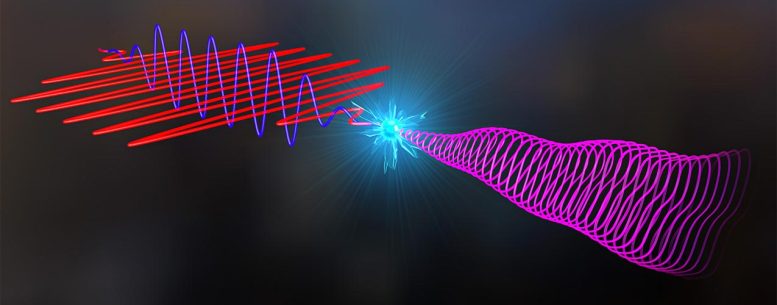
Two different powered, polarized lasers combine in the process of High Harmonic Generation. Credit
Steven Burrows/Becker Group
A new study by JILA introduces a straightforward method for generating elliptically polarized light, essential for advanced material research, challenging previous theoretical limitations.
In a new study published in Scientific Reports, JILA Fellow and University of Colorado Boulder physics professor Andreas Becker and his team theorized a new method to produce extreme ultraviolet (EUV) and x-ray light with elliptical polarization, a special shape in which the direction of light waves’ oscillation is changing. This method could provide experimentalists with a simple technique to generate such light, which is beneficial for physicists to further understand the interactions between electrons in materials on the quantum level, paving the way for designing better electronic devices such as circuit boards, solar panels, and more.
High-harmonic Generation Process
Many physicists use a process called High-harmonic Generation (HHG) as a source to generate ultrashort EUV and x-ray laser light and use this light to study the ultrafast dynamics of charged particles in different materials. By shooting high-powered laser pulses into a gas of atoms, the researchers can force the atoms to absorb the photons from the laser pulses. This causes the electrons in the atoms to jump to a higher energy level, then fall back to the ground level and emit energy as the atoms radiate in integral multiples of the laser frequency.
JILA graduate student and first author Bejan Ghomashi explained that “these [energies] will be the harmonics. So, if an 800-nanometer light is absorbed, it’s also emitted, along with 400 nanometers, 200 nanometers, etc.”
This process can be conveniently performed within a tabletop laser setup, as pioneered in the laboratories of JILA Fellows Margaret Murnane and Henry Kapteyn. It gives scientists a relatively cost-effective option to learn more about ultrafast electron dynamics.
“More people have access to an idea and can explore it,” Becker added.
Creating Polarization States of Light
Light polarization is a way to describe the direction in which light waves are oscillating. More specifically, polarization describes in which direction the oscillation of the electric field of the light in a laser beam varies over time. For example, the light’s electric field may wiggle along a line, making it linearly polarized. In other cases, the direction of the wiggling electric field may rotate, making the light circularly polarized. Creating light in which the electric field varies along an elliptical shape is a middle-ground between pure linearly and circularly polarized light.
Historically, it has however been challenging to produce elliptically polarized HHG light, but in this new study, Becker and his team explored how to use two linearly cross-polarized lasers at differing frequencies and directions to produce this desired shape. Unlike other, more complex, methods proposed to generate elliptically polarized HHG, an experimental set-up with two cross-polarized laser pulses interacting with an atomic gas is relatively simple.
Sources of elliptically polarized X-ray and EUV light can be useful in helping to study chiral and magnetic materials, as their electrons are sensitive to the direction of applied laser fields. Chiral materials, or materials with a special symmetry, are commonly found in foods and medicines. An example is aspartame sweetener: the left-handed version is sweet, while the right-handed version is not.
Resolving An Odd Puzzle
While previous theories had postulated that it is impossible to create elliptically polarized light using the configuration of two cross-polarized pulses, in 2015, an experimental study produced that exact result. Ghomashi elaborated: “At the time, theoretical physics had no explanation for the ellipticity generated in this experiment and argued it, in fact, should not exist. This was a puzzle to be resolved.”
Intrigued by this discrepancy, Ghomashi, recently graduated JILA Ph.D. student Spencer Walker, and Becker developed a method to analyze the experimental set-up in computer simulations. The results of those simulations produced the same results as found in the 2015 experiment for certain sets of parameters of the two cross-polarized laser pulses.
“You must find what we call the ‘sweet spot’—it is not just one parameter—but you have to tune several parameters simultaneously,” added Ghomashi.
Besides fiddling with the pulse length of the lasers, the researchers also fine-tuned the intensity (or the peak electric fields) of the two laser beams, where one beam was more intense than the other. The result of manipulating these two parameters created a “Goldilocks zone” for producing the rare, elliptically-shaped HHG light.
Walker elaborated that “by reducing the pulse duration, we control the amount of radiation in both [the x and y] directions simultaneously. And if you have emission in both directions at the right energy, you have ellipticity.”
Because of this method’s simplicity, the researchers hope that it will be possible for other physicists to reproduce their results in an experimental setup in order to validate their theoretical interpretation.
“It resolves an odd puzzle in the science community,” Becker stated, “which is always important for scientists and researchers.”
As JILA Fellows Margaret Murnane and Henry Kapteyn develop some of the world’s most precise table-top laser setups, testing the team’s concept at JILA would also be possible. “The mechanism, so how to change the knobs and why adjusting the parameters achieves the outcome, is very straightforward,” Walker said. “It’s just a matter of the details.”
Reference: “Enabling elliptically polarized high harmonic generation with short cross polarized laser pulses” by B. Ghomashi, S. Walker and A. Becker, 8 August 2023, Scientific Reports.
DOI: 10.1038/s41598-023-39814-y
>>> Read full article>>>
Copyright for syndicated content belongs to the linked Source : SciTechDaily – https://scitechdaily.com/quantum-lights-goldilocks-zone-perfecting-elliptical-polarization/






























Emma Vigeland Calls Out Hypocrisy Among Republican Women